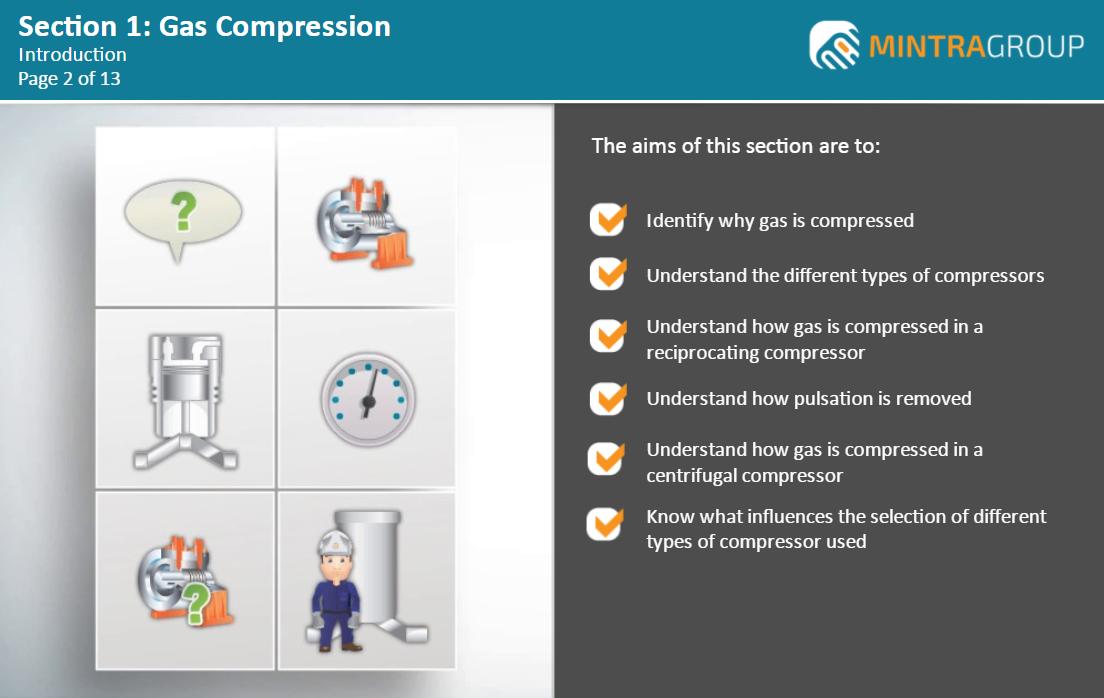Buy and assign to
multiple learners
Instant access
via email link
Instant certificate
via email
Further Information - Gas Compression Training
Description
Who is this course for?
This Gas Compression Training course is suitable for all relevant personnel
Is previous experience required?
You do not need prior knowledge or experience to complete this course and it is assumed that you are competent in your designated role
How will this course benefit me?
This course aims to provide an introduction to Gas Compression
The course has seven modules:
Module 1: Introduction to Gas Compression
Module 2: Gas Compression Systems
Module 3: Gas Compressors and their Principles
Module 4: Gas Compressors and their Components
Module 5: Gas Compression Systems: Controlling Surge
Module 6: Gas Compression Systems: Start-up and Shutdown
Module 7: Gas Compression Systems: Innovation
How will this course benefit my company?
To ensure you have had an introduction to Gas Compression
What standards are referred to in this course?
The course is made according to industry best practices.
Is there an assessment?
Once you have completed the course, you will be asked a series of questions to check your knowledge and understanding. These are based on the learning objectives for the course and have a pass mark of 80%.
Learning Objectives
• Explain why gas is compressed
• Identify the different types of compressors
• Explain how gas is compressed in a reciprocating compressor
• Explain how pulsation is removed
• Explain how gas is compressed in a centrifugal compressor
• Identify the influences that determine the type of compressor to be used
• Identify the various components of a typical gas compression system
• Identify the LP, MP and HP Compression Systems
• Explain the basic Gas Export System
• Explain the basic Gas Injection System
• Explain how and why the gas is supplied to the Gas Lift System
• Explain the basic Fuel Gas System
• Identify the components of a Single Stage Reciprocating Compressor
• Identify the principles of operation of a Double Acting Compressor
• Explain the purpose of Multistage Compressors
• Explain the reason for Interstage Cooling
• Explain how the efficiency of a Reciprocating Compressor is determined
• Explain capacity control and unloading devices
• Explain the different methods of control
• Explain the principles of cooling and lubrication
• Identify a Frame Type Compressor
• Identify the difference between fans, blowers and compressors
• Identify the types and reasons for different casing designs
• Explain the components of a Centrifugal Compressor
• Explain the purpose of different types of seals and their functions
• Explain the purpose of the Purge System
• Explain the purpose of the Lubricating Oil System
• Explain the purpose of Coalescers and Knock-Out Vessels
• Explain what is meant by surge
• Explain the effects of surge
• Identify what causes surge
• Explain how surge is prevented
• Identify Fast Control Surge Systems
• Identify the effect of stonewalling
• Explain how capacity control can be achieved
• Explain how and why an Inlet Guide Vane works
• Explain the key stages of centrifugal start-up
• Describe two ways of starting a centrifugal compressor
• Describe purging methods
• Explain why draining of compressor casings is important
• Describe the steps involved in pressurisation of a centrifugal compressor
• Explain the purpose of start-up permissives
• Identify the stage that the compressor discharge valve is opened
•Describe the different ways of shutting down a compressor
• Identify innovative compressor improvements
• Explain the purpose of Wet Gas Compressors
• Describe Inline Gas Compressors
Assessment
End of course assessment with an 80% pass mark.
System Requirements
• Internet access - users will need a device with a web browser and internet connection
• System - runs on computers, tablets and mobile devices using Windows 7 and above and MAC OS devices running IOS 11 and above
• Browsers - Edge, Chrome, Firefox and Safari
• Minimum browser size - none
• Audio - requires device speaker or headphones
Recommended Courses
Reviews
Insights & News
At Mintra, we're so much more than just a team—we're a force driving innovation and excellence in maritime training across Europe.
We’re excited to be taking the stage at one of Europe’s leading showcases of organisational learning.
We are delighted to share the exciting news that our People and Culture team has been shortlisted for the prestigious cHeRries Awards!




